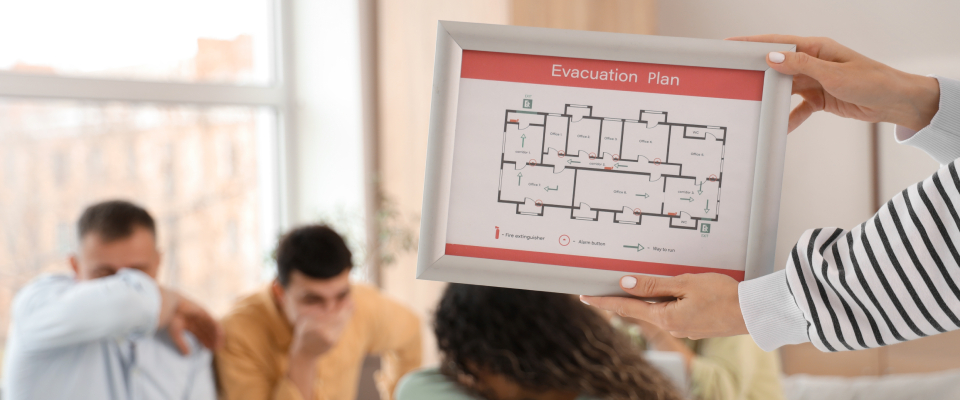Assessing a Building’s Emergency Preparedness: What to Look for During Your Apartment Search
Share this article:
When you’re looking for your happy place, it’s natural to get excited about granite countertops, in-unit laundry, or that perfect location near your favorite coffee shop. But here’s something that deserves just as much attention that’s often overlooked: building safety.
Fires, severe storms, floods, and power outages can strike without warning, and how well your apartment building handles these emergencies could be the difference between a minor inconvenience and a life-threatening situation. Learning to evaluate apartment building safety before you sign that lease will help you make smarter housing decisions and sleep better at night.
We’ll take you through everything you need to look out for, from property tours to details you need after you sign the lease.
Understanding building risks and vulnerabilities
When reviewing apartment building safety, start with the overall condition of the property. Signs like peeling paint, cracked windows, or ceiling stains may indicate underlying problems that could compromise safety during emergencies.
Location is just as important. An old tree that adds charm can also become a storm hazard. You should also check how close the home is to industrial areas or flood zones, which bring their own risks that require stronger safeguards.
Building codes are another key factor. Most cities mandate fire-resistant materials, sprinkler systems, and reliable emergency exits. When touring apartments, ask whether the property meets — or ideally exceeds — current codes.
Adding these to your checklist of apartment safety features to look for ensures that the building is not only compliant but also well-prepared to keep residents safe.

Key emergency preparedness features to look for
Every rental property should have certain devices and features that keep you safe in emergencies. During your property tour, keep an eye out for these critical apartment safety features:
- Smoke and carbon monoxide detectors: Every unit and common area should have them, and you should test them regularly. Ask when the last inspection happened.
- Fire extinguishers and sprinkler systems: Extinguishers should be easily accessible and clearly marked, while sprinkler heads should look clean and unobstructed.
- Emergency exits and escape routes: All exits should be well-lit, clearly marked, and free of clutter. Try walking the escape route yourself to see how quickly you could get out.
- Evacuation plans: Look for posted emergency maps in hallways and common areas, and ask if the building conducts regular evacuation drills.
- Emergency lighting: Backup lighting in hallways and stairwells can be a lifesaver during power outages — make sure these systems are in place and working.
These features form the backbone of building safety, so don’t be shy about asking detailed questions about each one.
Essential supplies and personal preparedness
Even the safest building can’t do everything for you — personal preparedness is key. Emergency experts recommend keeping a three-day supply kit with water, non-perishable food, flashlights, batteries, a first aid kit, a battery-powered radio, personal hygiene items, and any prescription medications you need.
If you or someone in your household has mobility challenges, ask specific questions about building safety accommodations. Do elevators have backup power? Are there accessible evacuation routes? Can emergency personnel easily reach upper floors? These considerations ensure everyone in your home can stay safe during an emergency.
Communication and information access
When a crisis hits, communication saves lives. Find out how your building plans to reach residents during emergencies. Does the building have internal alarms, a PA system, or emergency text and email alerts?
Create your own emergency contact list too, including local fire and police departments, EMS, utility companies, and building management contact information. Before signing your lease, make sure you understand exactly how you’ll receive critical information during an emergency.

Management responsiveness and community engagement
Great building safety starts with great management. Ask potential landlords about their emergency training and experience. Have they coordinated safety drills with residents? What’s their game plan for power outages, water main breaks, or severe weather?
Some of the best-prepared buildings partner with local fire departments, police, or neighborhood watch programs to strengthen their emergency response. A management team that actively works on building safety will likely be more responsive when you need them most.
5 questions to ask before leasing
Make your apartment search more effective with this apartment building safety checklist of questions for the leasing office:
- How often do you conduct emergency drills?
- Do you provide evacuation plan orientations for new residents?
- When were the smoke detectors and sprinkler systems last inspected?
- What emergency communication systems do you use?
- Has this property experienced any major emergencies like flooding or fires?
The answers to these questions will reveal how seriously the management takes building safety and whether they’re truly prepared for unexpected events.

Choosing an apartment is more than rent and floor plans — building safety should be a priority. Working smoke detectors, clear exits, responsive management, and reliable communication systems can make all the difference in an emergency.
By following an apartment building safety checklist and knowing the key safety features to look for, you’ll feel more secure and confident in your new home.
Share this article:
Florin Petrut is a real estate writer and research analyst with RentCafe, using his experience as a social media specialist and love for storytelling to create insightful reports and studies on the rental market. With a strong interest in the renter experience, he develops data-driven resources that explore cost of living, affordable neighborhoods, and housing trends, helping renters make informed decisions about where and how they live. Florin holds a B.A. in Journalism and an M.A. in Digital Media and Game Studies.
The Ready Renter has your back
Tips, news, and research curated for renters, straight to your inbox.




Related posts
Subscribe to
The Ready Renter newsletter






